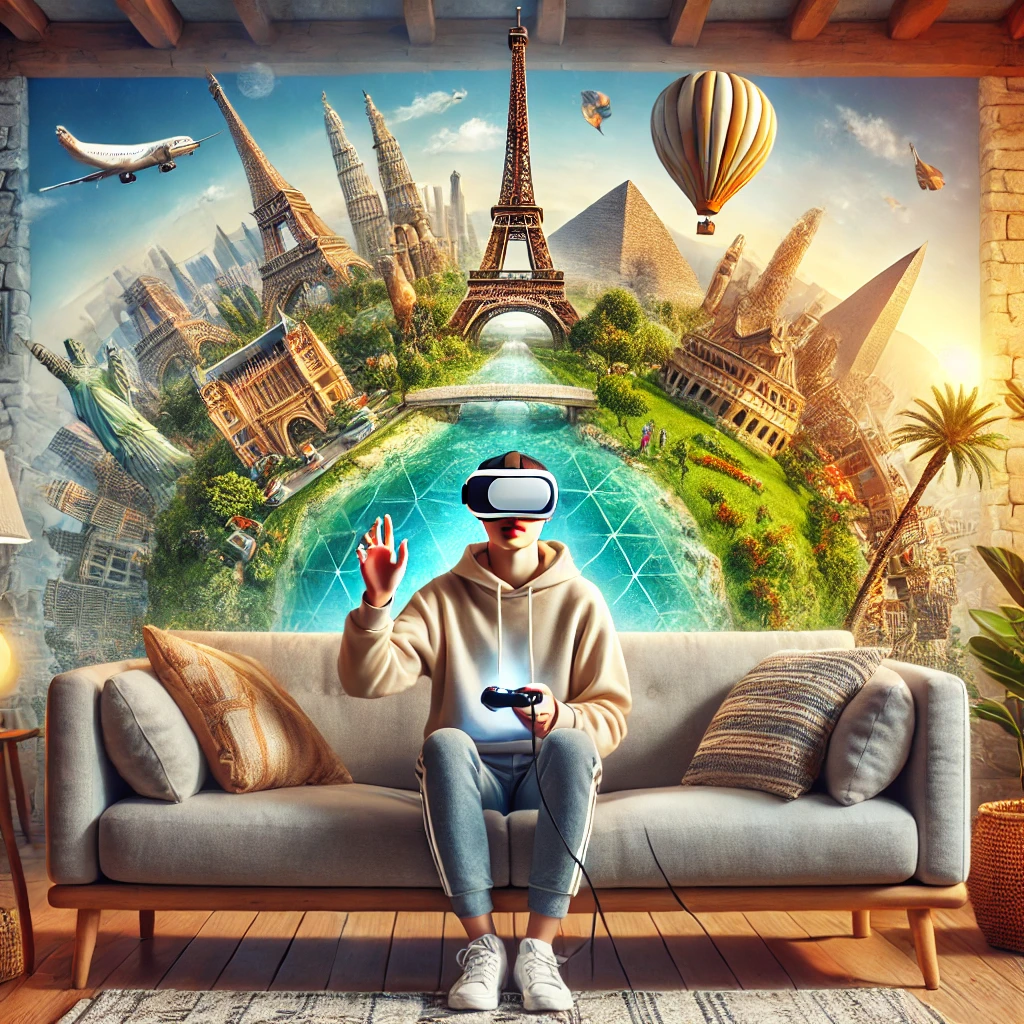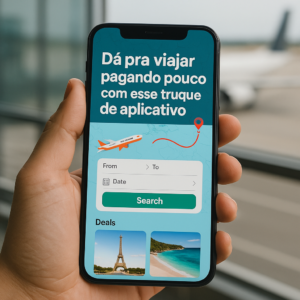Virtual Reality Travel
Imagine traveling to Paris, exploring the Colosseum in Rome, or hiking the Himalayan trails, all without leaving your home.
Sounds like science fiction? Not anymore. Virtual Reality (VR) is reshaping the way we experience the world, offering a new form of tourism:
Immersive, accessible and technologically fascinating.
This article is an invitation to explore, in detail, how VR is revolutionizing the travel experience, connecting people to destinations, cultures and stories in ways never seen before.
What is Virtual Reality in Tourism?
Virtual Reality is a technology that simulates three-dimensional environments, allowing users to interact with spaces and elements as if they were physically present.
In tourism, this means creating experiences that go far beyond photos and videos: visitors can “enter” historical monuments, museums, nature reserves and even luxury hotels without leaving their seats.
Thanks to devices like VR headsets and platforms like Google Earth VR, visual, auditory and in some cases sensory immersion has become part of the travel experience itself.
The boundary between real and virtual is increasingly blurred.
From the Couch to the Colosseum: Traveling Without Leaving Home
Imagine putting on a pair of virtual reality glasses and suddenly finding yourself in front of the Colosseum in Rome.
You can walk among the ruins, look up and admire the ancient architecture.
Everything in 360º, with a wealth of details and historical narrations that contextualize the place. This is already a reality.
Platforms like Wander, Oculus Venues and virtual experience apps are paving the way for virtual reality tourism.
Enabling people to explore the world with an internet connection and a headset.
For those who cannot travel due to financial, physical or logistical limitations, this is a revolution.
Museums, Cities and Hotels in 360º
Iconic museums such as the Louvre (France), the British Museum (UK) and the Smithsonian (USA) offer virtual reality tours where visitors can walk through galleries, see masterpieces and listen to stories told by curators and experts.
And all this without crowds or queues.
Cities like Dubai, Tokyo and New York offer guided VR experiences, with historical, cultural and architectural routes.
Luxury hotels use technology to present accommodations realistically to potential guests.
The future of destination choice may be to try first, book later.
The Power of Immersion: Benefits for the Traveler
- Accessibility: People with mobility limitations can explore the world with complete freedom.
- Economy: A virtual experience is more affordable than an international trip.
- Smart planning: Test destinations before booking real travel.
- Culture and education: Students can learn about geography, history and art in an interactive and immersive way.
Virtual Reality broadens horizons, democratizes access and enriches the tourist experience.
How VR is Transforming the Travel Industry
Travel agencies are creating packages with virtual reality experiences as a form of marketing and customer acquisition.
One example: showing a virtual visit to Greece before selling a cruise around the islands.
Companies like Thomas Cook and Expedia already use VR demos to promote destinations.
At tourism fairs and events, VR stands have become a must-see attraction.
Tour guides are beginning to offer VR services to remote clients, creating personalized experiences with real-time narration.
The Future: Trends and Innovations in Virtual Tourism
- Mixed Reality (MR): Union between real and virtual in the same experience.
- Avatars and social interaction: Virtual group trips, with friends, in real time.
- Gamification: Exploration of destinations with challenges, puzzles and virtual prizes.
- Full customization: Each user will have their own version of the destination based on preferences, history and travel style.
Virtual Reality and Inclusion in Global Tourism
For many people with mobility limitations, advanced age or restrictive socioeconomic conditions, Virtual Reality represents the first real chance to experience the world.
It breaks down physical and geographical barriers, allowing anyone to explore monuments, landscapes and cultures in a safe and accessible way.
Public schools in developing countries are using VR kits to take their students to the Louvre, the Great Wall of China or the bottom of the ocean.
The experiences are not only recreational, but deeply educational, fueling dreams and awakening interest in different cultures.
There are also initiatives that bring VR experiences to hospitals, nursing homes and isolated communities, providing emotional well-being and connection with the outside world.
This democratization of travel is reshaping the role of tourism: from a privilege to a tool for inclusion and empathy.
Sustainability and Virtual Travel
With growing concerns about climate change and the environmental impact of traditional tourism, Virtual Reality emerges as a low ecological impact alternative.
It eliminates the use of fossil fuels for travel, reduces the carbon footprint and prevents the degradation of natural and historical heritage.
Overcrowded destinations such as Venice, Machu Picchu or paradisiacal islands can be experienced in an immersive way without aggravating local infrastructure problems.
Furthermore, VR can function as an environmental awareness tool, showing visitors the effects of pollution, predatory tourism and the climate crisis.
Agencies and governments are beginning to invest in solutions that combine the passion for discovering new places with the responsibility of preserving them for future generations.
Virtual Tourism and the Renaissance of Imagination
In times of hyperconnectivity and excess information, Virtual Reality reactivates something we often forget: the ability to imagine.
When you put on a VR headset and see yourself in a Moroccan market, the Northern Lights, or a secluded mountain, you’re not just seeing—you’re living.
This sensation activates emotions, empathy and cultural connection.
It stimulates creativity, especially in young people, who begin to build narratives and see themselves as part of the globalized world.
Additionally, VR is being used by writers, artists, and content creators to develop scenarios, storylines, and inspiration.
Virtual tourism is not just exploration, but co-creation.
From this perspective, traveling with virtual reality is also a journey within yourself.
It’s a new way to cultivate the desire for authentic connections, even when mediated by technology.
SAQ – Frequently Asked Questions about Virtual Reality in Tourism
Do I need special glasses for virtual tourism?
Yes, for an immersive experience it is recommended to use VR glasses such as Oculus Quest, HTC Vive or similar.
Can virtual reality replace real travel?
No, but it complements it. It can help you decide, plan and enrich your knowledge about the destination.
Which platforms offer VR tourism?
Google Earth VR, Wander, Oculus Travel, AirPano VR, National Geographic Explore VR, among others.
Is virtual tourism paid?
Many content options are free. Some premium experiences require payment or a subscription.
What are the limits of VR in tourism?
Lack of tactile sensations, smells and direct human interaction. But technology is evolving fast.
Conclusion: A New Way to Travel
Virtual Reality opens a new chapter in tourism.
It's not about replacing the emotion of being there, but about multiplying possibilities, democratizing access and creating a new type of travel memory.
Traveling with Virtual Reality is traveling with expanded senses, with technology at the service of human curiosity.
What about you? Are you ready for your next trip… without leaving home?













